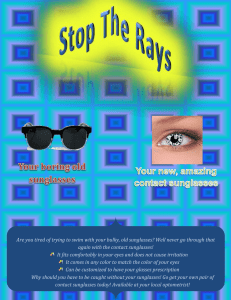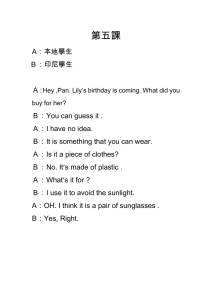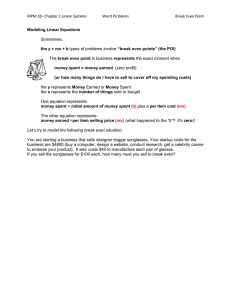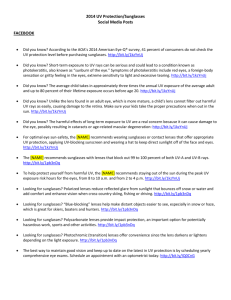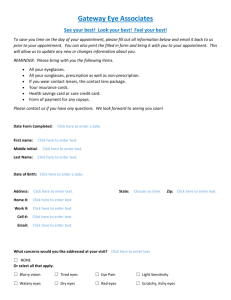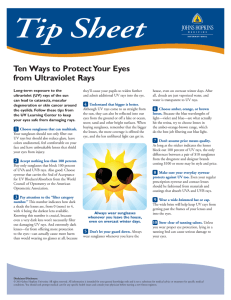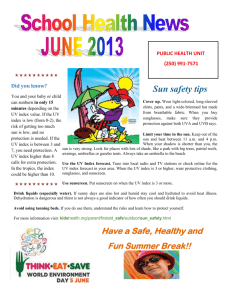SPARE YOUR SIGHT: Using Shades for
advertisement
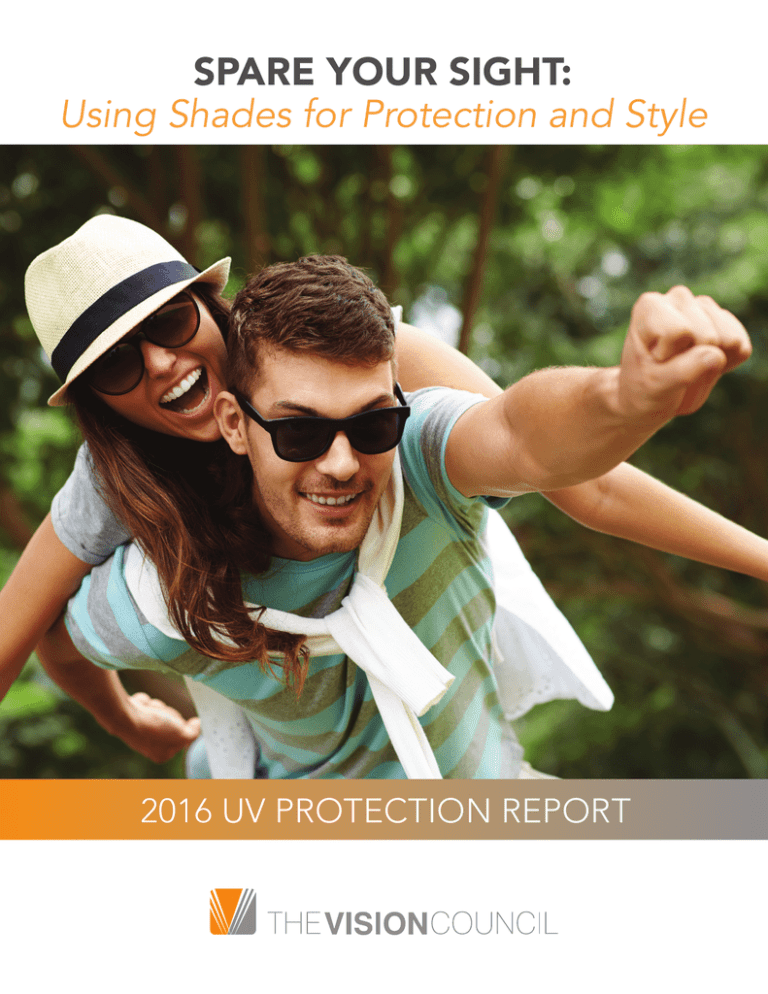
SPARE YOUR SIGHT: Using Shades for Protection and Style 2016 UV PROTECTION REPORT SPARE YOUR SIGHT: Using Shades for Protection and Style 75% of Americans are concerned about 31% wear sunglasses every time UV eye exposure yet only… Americans are more likely to identify the long-term on effects of UV their skin than on their eyes 26% they go outside 28% “I forgot to put them on” “I don’t have them with me” EXCUSES 17% “I’m not outside long enough to put them on” 11% “I don’t own prescription sunglasses” Parents likely to are more we (56%) ar shades tha children n their (29%) OUR FAVORITE ACTIVITIES REFLECT NEW DANGERS Americans are more likely to wear sunglasses: In the car: 73% In winter: 69% On a walk: 49% At the beach: 45% In the yard: 25% On the field: 6% Asphalt reflects up to 9% of UV 36% of Americans spend time outdoors between the hours of 2 p.m. and 4 p.m., when UV exposure to eyes is at its highest Water reflects up to 100% UV Snow reflects up to 85% of UV Grass reflects up to 3% of UV Concrete reflects up to 25% of UV Grass reflects up to 3% of UV USE OF SUNGLASSES BY GENERATION 20s 55% never, rarely or only sometimes wear sunglasses 30s 41% have experienced symptoms of UV eye exposure, including irritation of the eye (18%) and trouble seeing (16%) More than 1 in 3 adults have experienced symptoms from unprotected UV exposure. Learn how to spare your sight at thevisioncouncil.org/uv. thevisioncouncil.org 40s 32% report not having their sunglasses handy, exposing their eyes to damaging UV rays 50s 31% are concerned about vision loss from UV eye exposure but 24% aren't sure of the health effects of unprotected UV exposure 60s 40% spend time outdoors from 2 p.m. to 4 p.m., a peak time for strong UV rays SPARE YOUR SIGHT: USING SHADES FOR PROTECTION AND STYLE Executive Summary Sunglasses might be the unsung hero of American accessories. With just two small lenses, and sturdy, comfortable frames, the right sunglasses accomplish many feats that pair protection and style. They shade uncomfortable bright light and enhance contrast. Available in all shapes and sizes, they can help improve performance during sports and exercise, while sprucing up personal style. But most importantly, when used as directed, these small but mighty accessories can filter out the harmful ultra-violet (UV) radiation that penetrates and damages eyes. Shades are a must have when preparing to spend time outdoors – heading to the beach to hit the waves, going on a hike, or cheering on a favorite team. Oftentimes they dispel concern for keeping eyes comfortable in the bright daylight or ensure safety by shielding the sunset on a drive home. But what should always be the most important reason to wear shades, one that may get overlooked, is that sunglasses can spare sight from the short- and long-term effects of UV damage. Even though 75 percent of Americans report having concerns about UV eye exposure, less than one-third (31 percent) wear sunglasses every time they go outside, according to the 2016 VisionWatch survey of more than 10,000 adults 18 and older. The passive relationship that Americans have with their UV-protective eyewear is cause for concern. In a recent VisionWatch survey, more than one-third of adults have experienced symptoms due to prolonged UV exposure, such as eye irritation (16 percent), trouble seeing (14 percent) and red or swollen eyes (7 percent). Americans’ habits are likely to blame – many people are only sporting sunglasses when they are outside for two or more hours (39 percent), even though damage can start in as little as 15 minutesi. Additionally, activities in which UV-eye protection is vital are often conducted with exposed eyes – only 14 percent of Americans are likely to wear sunglasses while watching an outdoor sporting event and only 44 percent are likely to wear sunglasses at the beach. UVA/UVB protection should be the most important consideration in choosing a pair of shades Priorities in selecting shades also appear to be skewed. Americans place comfort (65 percent) and affordability (54 percent) before UV protection (44 percent). Checking the label to make sure sunglasses are UVA/UVB protective should be the most important consideration in choosing a pair of shades, instead of lens type or color. More than 40 percent of Americans believe that darker sunglasses provide better UV protection, although UV protection has nothing to do with the darkness or color. [An explanation of UV rays is available on Page 7.] What’s particularly noteworthy is that Americans see their vision as having the greatest impact on their day-to-day life – more so than other senses or cognitive skills, including loss of hearing, memory and speechii. According to the National Eye Institute, fear of vision-loss ranked second only to fear of cancer in public opinion polls conducted over the PAGE 3 past 40 yearsiii. For most people, wearing sunglasses is not a priority – sunglasses are often forgotten or just not on hand, whereas the use of sunscreen and hats to protect the skin from UV damage seem to be better understood and practiced. In fact, according to the VisionWatch survey, Americans are more likely to identify the long-term effects of the sun on skin, such as skin cancer (51 percent) and sunburn (42 percent), compared with the impacts on vision such as sunburned eyes (31 percent), cataracts (26 percent) or age-related macular degeneration (21 percent). Seeing life through sunglasses and other UV-protective eyewear helps prevent short- and long-term risk factors which can be damaging to the eyes. Short-term UV exposure can leave eyes bloodshot, swollen or hyper-sensitive to light. But over a longer term, this exposure can accelerate serious eye health problems, including cataracts, macular degeneration, abnormal growths on the eye’s surface, and cancers of the eye and surrounding skin. Because long-term UV damage is cumulative and irreversible, it is important to begin protective eyewear habits early; research has shown that young eyes are especially susceptible to UV-related harm. Kids, busy with playing outdoors and team sports, generally receive three times the annual sun exposure of adultsiv, spending the equivalent of approximately 55 days a year exposed to the sunv. Teens and young adults are also considered an at-risk age group for sun damage to the eye because the older they get, the less likely they are to use UV protection.vi According to the VisionWatch survey, those in their 20s are least likely to wear sunglasses every time they go outside, compared to all other age groups. In a study of active service members in the U.S. Armed Forces, sunburn diagnoses were highest among the youngest age group – a similar finding to other studies reporting prevalence of sunburn and sun exposure among teenagers and young adults in large populationsvii. Moreover, the time of day that people choose to spend outdoors also contributes to the risk of UV damage – more than one-third of adults go outside between the hours of 2 and 4 p.m., when UV exposure is at its highest. This is especially true for people whose profession involves working outdoors or at high altitudes, from construction workers to pilots to professional athletes. A recent study found that people performing outdoor work were more likely to have eyelid tumors caused by UV radiationviii. Because of this increased risk and exposure, people who work outdoors should consider sunglasses a mandatory work accessory. With the latest lens technology and the availability of lighter, sturdier and more stylish frames, reaching for a favorite pair of sunglasses shouldn’t be a hassle. It’s possible to keep eyes safe and comfortable at the same time. The Vision Council commissioned the VisionWatch survey in December 2015, surveying 10,279 adults 18 and older about their sunglass use and habits, and knowledge around UV radiation through an online survey tool. The purpose of this report is to educate consumers about the dangers of UV, correct misconceptions about sunglasses and UV protection, and share advice on selecting the right shades. For complete research method, including subgroup sample sizes and weighting variables, please contact The Vision Council. thevisioncouncil.org SPARE YOUR SIGHT: USING SHADES FOR PROTECTION AND STYLE Q&A with Justin Bazan, OD, Medical Advisor to The Vision Council Helping patients see the connection between sunlight and our eyes is critical to maintaining good eye health. Here are a few frequently asked questions from my patients: Q: When do UV rays affect my eyes? A: UV radiation is present year-round. We are more likely to notice and feel the impact of the sun on our skin in the summer when the UV index is higher, but in winter months, UV rays can reflect off snow and into the eyes. In the afternoons, UV exposure is highest between the hours of 2 p.m. and 4 p.m., so it’s imperative to wear sunglasses during those peak times. Q: If the sun doesn’t bother my eyes, do I still need to wear sunglasses? A: While certain characteristics such as eye color, geography and age can increase the risk from UV exposure, no one is immune to its effects. Even if it doesn’t “bother” you, it could be putting your eyes at risk. Everyone should be in the habit of keeping their sunglasses on or close to them at all times. The dangers of unprotected UV exposure often are not recognized and the damage it causes is cumulative and irreversible. Q: Is there a pair of sunglasses you recommend? A: Evaluate your daily activities – driving, walking, gardening, playing sports – and determine which type of eyewear is most conducive to your lifestyle. Quality sunglasses are available for every budget, but you should make sure they come from a reputable retailer. The most important considerations when making eyewear purchases are: UV protection and comfort. Q: What are your recommendations for protecting my children’s eyes? A: Children generally receive about three times the annual adult dose of UV, which can lead to serious eye damage later in life. Look for child-appropriate sunglasses that feature a strap or that are adjustable. Shopping for the right pair alongside your child may help encourage him or her to use them, if they are comfortable and stylish. Parents should set an example for proper eye protection by wearing sunglasses every time they go outside as well. I always encourage my patients to ask questions if they are ever unsure about the sun and their eyes. To help ensure their eyes are safe, I test my patients’ sunglasses for UV protection and suggest UV-protective lenses in their regular prescription eyewear as well. An eyecare provider can make recommendations tailored to your vision and lifestyle needs for purchasing and using sunglasses for people of all ages. Having a comprehensive annual eye exam is an important part of keeping eyes healthy. Preventative steps taken today will create a brighter future. PAGE 5 The Underestimated Danger Americans’ lax approach to sunglass use reveals that they are likely underestimating the danger of UV. More than one-third of adults have experienced problems from UV exposure, including sunburn of the eye, red or irritated eyes, trouble seeing, wrinkles, and/or cancer on the eye. However, many Americans remain unconcerned or uneducated about the consequences of too much UV. The recent VisionWatch survey found that many adults (39 percent) only wear sunglasses if they are outside for an extended period, and, when it comes to buying shades, are more concerned about fit (65 percent) and affordability (54 percent) than UV protection (44 percent). While fit and affordability are certainly important factors, overlooking proper UV protection has the greatest detrimental impact. Women are more likely than men to wear their sunglasses always or often (58 percent vs. 48 percent), but no one is immune to the harmful effects of UV exposure. While genetics, geography, hobbies, and lifestyle account for our time in the sun, men, women and children alike are at risk for eye-related diseases and problems. The knowledge gaps among Americans may be a reason they aren’t taking eye protection more seriously. According to the survey, 42 percent of adults believe darker sunglasses provide more UV protection. However, dark lenses without adequate UV protection can actually be worse than no sunglasses at all because they cause the eye’s pupil to dilate, which then increases retinal exposure to unfiltered UV. Additionally, adults surveyed are more aware of the long-term effects of unprotected UV exposure on skin, compared to the impact on vision. Use of UV-protective eyewear during childhood – and into teen and adult years – can mitigate serious vision problems and help maintain healthy eyes well into our older age. Skin cancer While most people are aware of skin cancer and sunburn as health effects of unprotected ultraviolet (UV) exposure, the immediate and long-term risks to eyes are lesserknown dangers. thevisioncouncil.org Sunburned skin Sunburned eyes Cataracts 76% 70% 42% 35% AMD 35% Other health effects 22% Unaware or unsure 12% SPARE YOUR SIGHT: USING SHADES FOR PROTECTION AND STYLE Shades by Generation KIDS Prevent Harm to Young Peepers: Kids generally receive three times the annual sun exposure of adultsix, and their young eyes are especially susceptible to UV-related harm. This increased risk hasn’t translated to increased protection – 56 percent of parents report wearing sunglasses always or often, but only 29 percent of parents say their children always or often wear shades. 20s Style Reigns Supreme: Millennials in their 20s may be more concerned with making a fashion statement than protecting their eyes from long-term damage – 55 percent never, rarely or only sometimes wear sunglasses. 30s Sunglass Savvy: People in their 30s are more responsible about caring for their eyes, possibly because 41 percent have experienced negative symptoms related to UV eye exposure. Fifty-eight percent always or often wear sunglasses, more than any other age group. 40s Learning from Bad Habits for Better Health: Many folks in their 40s have felt the pain of UV rays on unprotected eyes, but have learned their lesson, keeping their shades close at hand. More than two-thirds keep their sunglasses handy, protecting their eyes from UV. 50s The Aging Agenda: As people in their 50s experience vision changes that accompany aging, they are more concerned with protecting their vision and the health effects of UV exposure; however, 24 percent admit they forget to put them on before heading out the door. 60+ A Senior’s Perspective: Reaching their retirement years, 40 percent of Baby Boomers are more likely to spend time outdoors during peak UV times, accelerating the damage to their retinas. While many are enjoying longer, healthier lives, 35 percent are concerned about vision loss, but 26 percent are unsure of the health effects of unprotected UV exposure. PAGE 7 Dark Side of UV According to The Vision Council’s research over the past several years, many misjudge the dark side of UV when it comes to our eye health. While the eyelid is designed to limit the amount of UV radiation entering the eye, the thin, delicate tissue is not entirely effective at protecting the cornea – the clear surface of the eye. Comprehensive annual exams with an eyecare provider can help diagnose these disorders when they are still most treatable. Short-Term UV-Related Damage: Just as our skin can feel the burn after several hours in the sun, spending time with intense, unprotected exposure to UV radiation can cause a variety of short-term problems in our eyes. While these conditions are temporary, they can be irritating and painful. Although short-term effects of UV eye damage may diminish, the cumulative UV exposure can yellow both the lens and the cornea, making it more difficult to see contrast. Photokeratitis is sunburn of the cornea. While the damage is not permanent, the pain can be severe. The condition is also known as “snow blindness,” a reminder that snow has been found to reflect up to 80 percent of the sun’s rays and that UV danger is not limited to summertime at the beach.x Only 31% of Americans are aware that unprotected UV exposure can cause sunburned eyes. Cornea Iris Retina 31% Pterygium, sometimes called “surfer’s eye,” is an abnormal but usually benign growth on the surface of the eye, most often originating in the corner near the nose. Pterygium is linked to excessive exposure to sun, wind, or sand. It may cause irritation, swelling and itchiness as well as corneal problems that can affect vision. Sunglasses and other UV eye protection help with prevention, and while the symptoms may be resolved through surgery, they also can recur. Childhood UV exposure increases the risk of pterygium, and the growth usually emerges long before skin conditions, so it may be an early indicator of serious UV damagexi. If a pterygium is large enough, it can actually affect the shape of the cornea’s surface, leading to astigmatismxi. thevisioncouncil.org SPARE YOUR SIGHT: USING SHADES FOR PROTECTION AND STYLE Long-term UV Eye Diseases: The unfiltered UV radiation we receive over a lifetime can contribute to serious eye disorders and pose risks to eye health later in life. This cumulative damage may not be visible right away, but this hidden danger can be prevented by wearing UV-filtered protection. The most common complications of prolonged UV exposure include: Cataracts, the most common cause of vision loss in people 40 and older, are the progressive clouding of the lenses of the eyes. Untreated cataracts are globally ranked as one of the main causes of reversible blindness. The World Health Organization (WHO) estimates that up to 20 percent of all cataract cases are attributable to UV radiation and are preventablexiii. Approximately three million surgeries to remove cataracts are performed in the U.S. annually, and more than 20 million Americans have cataracts, according to Prevent Blindness America. 26% 21% Only 26% of Americans are aware that cataracts are a health effect of unprotected UV exposure. Age-related macular degeneration (AMD), is another major cause of vision loss in older people and the leading cause of blindness in adults 60 and older. The macula is the part of the retina that enables the sharp, central vision needed for reading or driving. Higher UV exposure at an earlier age, especially for people who have long worked outdoors, has been significantly associated with early AMDxiv. Epidemiological studies suggest that exposure to UV early in life, rather than in later years, is a stronger predictive factor for developing AMDxv. Sunlight— particularly UV radiation—can induce photo oxidative stress in the retina and may initiate and drive aging events that lead to AMD. Vision loss from this disease is irreversible, though early detection and treatment can slow further loss. Only 21% of Americans are aware that unprotected UV can contribute to AMD. Cancer of the eye, eyelid and surrounding skin: Although cancer of the eyeball itself is relatively rare, skin cancers around the eye are not. According to the Skin Cancer Foundation, one-tenth of all skin cancers are found on the eyelid. Most are diagnosed as basal cell carcinoma, which can spread to the eye and adjacent tissue, but is not malignantxvi. Nearly 3,000 intraocular cancer cases are diagnosed in the U.S. annuallyxvii, yet only 8 percent of Americans say they are concerned about cancer of the eye. Melanoma is the most frequent malignancy of the eye and often requires surgical removal. Exposure to UV radiation, especially UVB, is the most common cause for eyelid tumorsxviii. 18% 8% 18 percent of survey respondents are concerned with skin cancer, but only 8 percent are concerned with cancer of the eye. PAGE 9 NON-VISIBLE VISIBLE UV POTENTIALLY HARMFUL LIGHT [UV] [BLUE-VIOLET] Cataract AMD BENEFICIAL LIGHT [BLUE-TURQUOISE] [REST OF VISIBLE LIGHT] Sleep/wake cycle Memory What’s in a ray? The sun emits three kinds of radiation: UVA, UVB, and UVC. While UVC gets absorbed by the Earth’s atmosphere, UVB radiation is only partially blocked and is able to burn the skin and the eyes, causing everything from bad sunburns to cancer. UVA rays are not filtered and cause the most damage to vision health. Direct sunlight is not the only source of danger from UVA and UVB radiation: both types of rays reflect off surfaces such as water, snow, sand, concrete, and even buildings. Reflected UV increases exposure levels and can double UV risk to the eyes in certain conditions, particularly with water and snow.xix ! Reflected UV light is just as damaging as direct UV Water reflects up to 100% Dry sand and concrete reflect up to 25% ❄ Snow reflects up to 85% thevisioncouncil.org Grass reflects up to 3% SPARE YOUR SIGHT: USING SHADES FOR PROTECTION AND STYLE UV radiation can be harmful to eyes no matter the weather conditions—during all seasons of the year. However, the level of exposure varies by location, depending on the proximity to the equator and high altitude, where thinner atmosphere means less filtering of the sun’s rays. The Vision Council analyzed national UV index levels in 2015 and tabulated data of the 25 cities with the most days of extreme and very high UV risk, based on data from the U.S. Environmental Protection Agency and the National Oceanic and Atmospheric Association. 23 20 22 15 10 25 6 11 19 21 18 17 16 13 9 5 14 Rank 1 2 3 4 5 6 7 8 9 10 11 12 13 City San Juan Honolulu Miami Tampa New Orleans Albuquerque Jacksonville Mobile Houston Los Angeles Phoenix Charleston Jackson Total Days of Extreme and Very High Risk % Annually 312 283 230 199 184 183 176 175 172 172 168 155 155 85% 78% 63% 55% 50% 50% 48% 48% 47% 47% 46% 42% 42% Rank 14 15 16 17 18 19 20 21 22 23 24 25 12 8 4 2 24 7 City Atlanta Las Vegas Dallas Memphis Little Rock Raleigh San Francisco Oklahoma City Denver Salt Lake City Norfolk Wichita 1 3 Total Days of Extreme and Very High Risk % Annually 149 141 137 134 129 127 123 123 121 120 117 106 41% 39% 38% 37% 35% 35% 34% 34% 33% 33% 32% 29% PAGE 11 Myths vs Facts Some of the myths that surround UV protection may also steer Americans away from taking UV damage seriously: Myth #1: All sunglasses have UVA/UVB protection. FACT: Despite the health risks of UV exposure, not all sunglasses have UV protection. Since shielding eyes from damaging radiation is crucial, it is imperative to look for a label, sticker or tag indicating UV protection before purchasing a pair of sunglasses. Myth #2: The darker the sunglasses, the better the protection. FACT: UV protection has nothing to do with the darkness or color of a lens; however 42 percent of people surveyed believe it does. Dark lenses without adequate UV protection can actually be worse than no sunglasses at all because they cause the eye’s pupil to dilate, which then increases retinal exposure to unfiltered UV. In fact, many eyecare providers recommend that every day, clear prescription glasses be UV protective. Myth #3: You don’t need sunglasses on cloudy days. FACT: UV rays are just as dangerous on cloudy days as on clear days. Just like skin, eyes can accumulate harmful UV radiation on overcast days, so be sure to wear proper eye and skin protection while outside. Myth #4: Sunglasses are not appropriate for people with prescription glasses. FACT: Anyone who is exposed to UV should protect themselves with sunglasses. People who regularly wear prescription glasses should wear prescription sunglasses when outside, or purchase photochromic lenses that transition to sunglasses when exposed to UV light. And even those with contacts should wear sunglasses to protect exposed parts of the eye. Myth #5: The sun is weaker in the winter, meaning eyes are safer and less apt to be exposed to damaging UV rays. FACT: Similar to cloudy days, cold days also carry UV risk. The sun is present year-round which means UV rays are a constant, regardless of weather. UV rays can’t be seen but their long-term effects are damaging to the eyes. thevisioncouncil.org SPARE YOUR SIGHT: USING SHADES FOR PROTECTION AND STYLE Uses and Excuses: Americans fear blindness more than loss of any other sense and ranked it among the top four “worst things that could happen to you”xx. So why do we continue to see a significant number of Americans “forget” or “neglect” to reach for their sunglasses every time they walk out the door? The Vision Council looked into the common uses and excuses about sunglass wear: USES Americans are more likely to wear sunglasses while driving (73%) than while at the beach (45%). Only 49% of Americans are likely to wear their shades when walking outside. Of the people who rarely or never wear sunglasses, 44% don’t own sunglasses. Style Profile / EXCUSES “I don’t have them with me.” – 28% “I forget to put them on.” – 26% “I’m not outside long enough to put them on.” – 17% Comfort and affordability are Americans’ top priorities when it comes to picking out shades – but there are other factors to consider. A wide variety of sunglasses have been designed by the optical industry for everyday needs. The following Style Profiles highlight individuals who partake in various lifestyles and activities where shades are a must. What makes up your Style Profile? The Road Warrior – Whether it’s a quick commute or a weekend away, you don’t hesitate to hop behind the wheel. It’s important to prioritize eye protection to get from point A to point B, as concrete can reflect UV light up to 25 percent. In addition, an anti-reflective lens would help reduce distracting reflections and improve contrast to help you stay focused on the road ahead. The Multi-Tasker – Between a weekend with the grandkids, Tuesday yoga class and Wednesday’s yard work, it’s hard for you to find free time. Life demands a lot from you. A photochromic lens is ideal for someone who wears many hats, since these sunglasses easily transition from clear to dark when exposed to UV radiation, perfect for when you go from cooking to gardening. The Beach-Bum – Life is a beach—in your mind, there’s nothing better than surf, sand and sun to unwind and recharge. But hours soaking in the rays can wreak havoc on eye health. The next time you pack up your beach bag, grab a pair of polarized sunglasses to filter out the reflected glare from the water. Polarized lenses are ideal for people on the water, as they improve contrast and visibility and reduce squinting. The High School Goalie – Your daughter is on track to break her school record for most saved goals. But between weekend tournaments, math tutoring and violin practice, you don’t think about protecting her eyes from UV rays. Sunglasses with large frames, adjustable straps or wraparound features will help busy kids like her keep track of her shades and also increase the comfort level so she’s more likely to want to wear them. Impact-resistant sunglasses are also a must for high-impact or competitive sport use. PAGE 13 Balancing Protection with Style: Types of Sunglass Lenses • Photochromic lenses automatically darken and lighten to provide the best level of protection and comfort. • Anti-reflective lenses reduce distracting reflections while improving contrast, visual acuity, and comfort. • Mirror-coated lenses reflect light across a wide spectrum, including infrared or heat rays. • Polarized lenses filter out reflected glare from shiny surfaces, while improving contrast and visibility. • Impact-resistant lenses are best for high-impact or competitive sport use. • Magnetic lenses can be easily popped out and switched for a different lens. Lens Tinting • Solid tinted lenses are evenly tinted across the entire lens to cut glare from all directions. • Gradient-tinted lenses are darker at the top and lighter at the bottom to cut overhead glare and provide clearer vision when looking straight ahead or down. • Double-gradient lenses are darker at the top and bottom and lighter in the center to cut overhead and reflected glare from the ground while providing clearer vision straight ahead. • Brown/amber/copper lenses reduce glare and improve contrast and visibility for selectively filtering blue light. • Gray/green-gray lenses are general-purpose tints that reduce glare while maintaining natural colors. • Yellow/rose lenses enhance contrast and definition, especially in lower-light conditions such as fog and haze. Conclusion For years, Americans have associated sun exposure with the effects it has on their skin, but it’s time to widen our field of vision to bring eye health into perspective: sunglasses are actually a health necessity. If the average U.S. adult spent just 30 minutes wearing a pair of sunglasses with adequate UV protection during the day, their eyes would gain nearly 183 hours of UV-free time over the course of a year. This protection is key to slowing the acceleration of serious eye diseases that Americans may face if they don’t take UV eye protection seriously. The Vision Council is committed to reducing the knowledge gaps and helping Americans spare their sight through increased awareness, education and information on the latest technology in the eye care industry. Adults and children alike should never overlook the health benefits that sunglasses can provide. By establishing good habits and prioritizing vision health today, we protect our eyes for the future. For more information, and to access the report, visit www.thevisioncouncil.org/UV. thevisioncouncil.org SPARE YOUR SIGHT: USING SHADES FOR PROTECTION AND STYLE Endnotes i http://www.cdc.gov/cancer/skin/basic_info/sun-safety.htm ii Attitudinal Survey of Minority Populations on Eye and Vision Health and Research. Association for Research and Vision in Ophthalmology (ARVO). 2014 iii http://www.eyeresearch.org/resources/NEI_factsheet.html iv Prevent Blindness America. Children’s Eyes More Susceptible to Long-term Damage from UV Rays, April 2010 v Journal of European Academy of Dermatology and Venerology. “Evolution of Sun-Protection Measures for Children.” 2015. Cancer Epidemiol Biomarkers Prev. “Sun Protection Practices and Sun Exposure among Children with Parental History of Melanoma”. January 2015. vi vii Sunburn Among Active Component Service Members, U.S. Armed Forces- 2012-2013. viii D. Karlica-Utrobicic et. al. “Changes in the Eyelids and Conjunctiva Caused by Ultraviolet Radiation.” 2014. ix Prevent Blindness America. Children’s Eyes More Susceptible to Long-term Damage from UV Rays, April 2010 x “UV Radiation.” Ultraviolet Radiation and the INTERSUN Programme. World Health Organization. Web. 11 Apr. 2016. xi American Journal of Ophthalmology, Sept. 2005 xii http://www.aao.org/eye-health/tips-prevention/pinguecula-pterygium World Health Organization. “Ultraviolet Radiation and the INTERSUN Programme.” http://www.who.int/uv/faq/uvhealtfac/en/index3. html xiii xiv Retina, the Journal of Retinal and Vitreous Diseases. “History of Sunlight Exposure is a Risk Factor for AMD”. 2015. xv Clinical and Experimental Optometry, Aug, 2010 xvi Skin Cancer Foundation. The Eyelids: Highly Susceptible to Skin Cancer (Accessed online) xvii Eye Cancer. American Cancer Society, 2013. http://www.cancer.org/cancer/eyecancer/detailedguide/eye-cancer-key-statistics xviii D. Karlica-Utrobicic et. al. “Changes in the Eyelids and Conjunctiva Caused by Ultraviolet Radiation” 2014. xix “UV Radiation.” Ultraviolet Radiation and the INTERSUN Programme. World Health Organization. Web. 11 Apr. 2016. xx “New poll: Americans fear blindness more than loss of other senses, strongly support more funding for research” (ARVO) 2014 http:// arvo.org/About_ARVO/Press_Room/New_poll__Americans_fear_blindness_more_than_loss_of_other_senses,_strongly_support_more_ funding_for_research/ PAGE 15 225 Reinekers Lane Suite 700 Alexandria, VA 22314 703.548.4560 703.548.4580 (fax) thevisioncouncil.org About The Vision Council: Serving as the global voice for vision care products and services, The Vision Council represents the manufacturers and suppliers of the optical industry through education, advocacy and consumer outreach. By sharing the latest in eyewear trends, advances in technology and advice from eyewear experts, The Vision Council serves as a resource to the public looking to learn more about options in eyeglasses and sunglasses.
